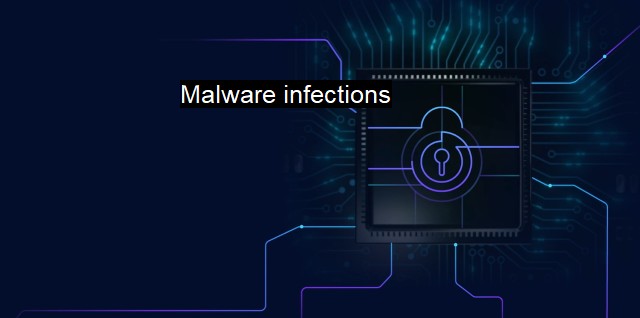What are Malware infections?
Confronting Malware: The Threats and Risks to Cybersecurity in Today's World
Malware, a portmanteau of 'malicious software', is any software intentionally designed to cause damage to a computer, server, client, or computer network. Each year, millions of computers worldwide become infected with some form of malware, resulting in billions of dollars of financial damage. Malware includes viruses, ransomware, spyware, adware, Trojans, and worms, all designed to breach and interfere with the operations of computers and computer networks without the knowledge or consent of the owner. The topic of malware infections is a crucial aspect of cybersecurity, underscoring the need for robust antivirus systems.Broadly, malware infections differ in their manner of operation, but most work by exploiting vulnerabilities in operating systems, plug-ins, browsers, or applications. Sophisticated and aggressive malware may also employ tools such as keyloggers or network monitoring software to capture sensitive information surreptitiously, leading to severe privacy risks and often financial losses.
As the chief mutational vehicle of malware, viruses attach themselves to executables and are activated when a human user runs the comprising executable or application. The repercussions are usually damaging, ranging from cause system slowdowns, data corruption, file deletion or alteration to making a system completely nonfunctional. Viruses are frequently distributed through email attachments or nefarious downloads.
Ransomware, a severe breed of malware, encrypts files and operations on a victim's computer and then demands a ransom, often in the form of digital cryptocurrency, to unlock them. Failure to pay could mean the irretrievable loss of essential files. The infamous WannaCry ransomware attack in May 2017 infected over 200,000 computers across 150 countries.
Equally troubling are Spywares, which surreptitiously monitor user activities, record keystrokes and report back to the attacker with sensitive information, like credit card numbers or login credentials. Adware, on the other hand, bombards users with unwanted advertisements and can also redirect browser searches to earn ad revenue. Some adware can be much bolder, serving as conduits through which other forms of malware gain access to a system.
Trojans are malware masquerading as legitimate software that users are tricked into loading onto their systems. Once inside, they create a backdoor that gives hackers the ability to take control, steal sensitive data or download more malware. Worms, another common type of malware, self-replicate to spread to other computers over a network. A well-known instance was the ILOVEYOU worm, which caused damage costing an estimated $10 billion.
Effective cybersecurity strategies are paramount in combating malware infections. Antivirus software is the primary line of defense, capable of scanning, detecting and blocking suspicious files, and regularly updated to keep definitions of the latest malware trends. User caution is also essential such as avoiding clicking on suspicious emails or downloading dubious attachments.
Firewalls act as a barrier between trusted and untrusted networks, scrutinizing inbound and outbound traffic based on specified rules to block unwanted network communications. Also, updating the operating system and applications guarantees that the latest security patches fix known vulnerabilities, reducing the chances of a malware infection. Intrusion Detection Systems and Intrusion Prevention Systems can monitor networks and systems for malicious activities and log information about such activities or attempt to stop them.
Malware infections are a critical threat in the ever-evolving landscape of cybersecurity. Cyber threats continue to become more sophisticated, hence the higher dependency on robust antivirus and advanced cybersecurity strategies to protect computer and network systems from these malicious software attacks. Awareness, periodic updates, and secure gating behavioral caution can prevent a majority of malware infections, marking the human user as the essential asset in the war against cybercrime. Today, mitigating the risk of malware infection is not just an IT priority, but instead a core concern across all digital touchpoints in a progressively interconnected world.

Malware infections FAQs
What is a malware infection?
A malware infection is when malicious software, commonly known as malware, infiltrates a computer or a network to cause harm or damage by stealing personal information, corrupting files, or creating unauthorized access to targeted systems.How do malware infections occur?
Malware infections can occur in various forms, such as through email attachments, malicious links, software downloads from untrusted sites, or through removable storage devices like USB drives. Hackers use a variety of methods to trick users into downloading and installing malware on their devices.What are the signs of a malware infection?
Signs of a malware infection include slow computer performance, frequent crashes, pop-up ads, suspicious browser toolbars, unauthorized changes to files, and unusual network activity. These signs may indicate that malware is present on the device or network and requires immediate attention.How can I protect my devices from malware infections?
To protect devices from malware infections, ensure that you have up-to-date antivirus software installed and keep it updated. Be cautious with emails, avoid downloading files or clicking on links from untrusted sources, and regularly back up your data. Additionally, use strong passwords and enable automatic updates for your operating system and applications.| | A | | | B | | | C | | | D | | | E | | | F | | | G | | | H | | | I | | | J | | | K | | | L | | | M | |
| | N | | | O | | | P | | | Q | | | R | | | S | | | T | | | U | | | V | | | W | | | X | | | Y | | | Z | |
| | 1 | | | 2 | | | 3 | | | 4 | | | 7 | | | 8 | | |||||||